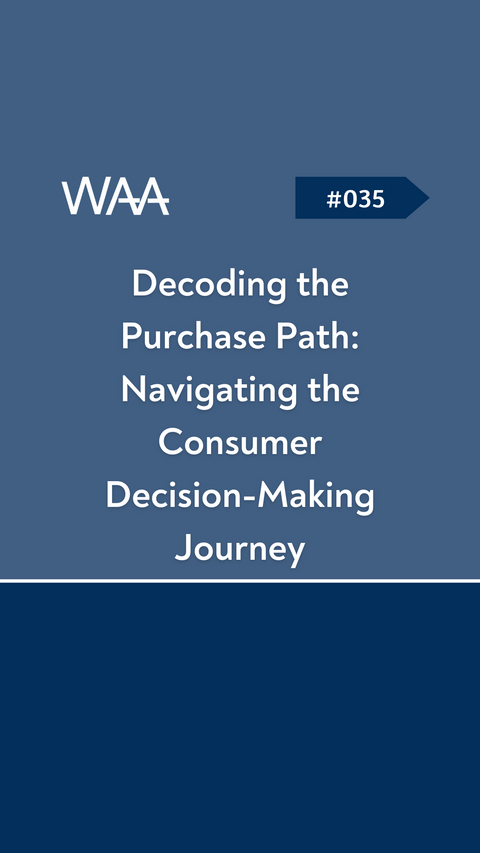
#035 Decoding the Purchase Path: Navigating the Consumer Decision-Making Journey
Consumer Decision-Making Process Explained
Understanding the consumer decision-making process is crucial for brands and marketers seeking to connect with their target audience effectively. By delving into the factors that influence consumer decisions, brands can tailor their branding and marketing strategies to align with consumer psychology, ultimately increasing engagement and driving sales. In this blog post, we will explore the consumer decision-making process and its implications for branding, marketing, and consumer psychology.
The Consumer Decision-Making Process
The consumer decision-making process is a series of steps that individuals go through when making a purchase decision. It involves several stages, each influenced by various internal and external factors. Let's walk through the five key stages in the consumer decision-making process:
-
Need Recognition: The process begins with the consumer recognizing a need or a problem that requires a solution. This could be triggered by internal factors, such as personal desires or unmet needs, or external factors, such as advertising or information from friends.
-
Information Gathering: Once the need is recognized, consumers engage in information gathering to explore possible solutions. They seek information from various sources, such as online research, reviews, recommendations, and personal experiences. Brands must ensure that accurate and comprehensive information is readily available to consumers during this stage.
-
Evaluation of Alternatives: Consumers evaluate the available alternatives based on specific criteria important to them. They compare products or services based on features, pricing, brand reputation, and other factors, narrowing down their options to a few preferred choices. At this stage, brands need to highlight their unique value proposition and differentiate themselves from competitors.
-
Purchase Decision: The consumer makes the final purchase decision, either selecting the brand they perceive as the best fit for their needs or making trade-offs between different options. Factors that influence this decision include pricing, perceived value, brand reputation, and emotional connection. Brands should strive to provide a seamless and convenient purchasing experience to facilitate decision-making.
-
Post-Purchase Evaluation: After the purchase, consumers evaluate whether their expectations were met or exceeded. This evaluation determines their satisfaction and influences future brand loyalty. Brands can actively engage with customers during this stage to gather feedback, address any concerns, and reinforce positive experiences.
Implications for Branding and Marketing
Understanding the consumer decision-making process can help inform branding and marketing strategies, leading to improved customer engagement and increased sales. Here are some key implications:
1. Branding and Consumer Psychology:
Branding plays a critical role in creating perceptions and influencing consumer behavior. By aligning branding efforts with consumer psychology, brands can appeal to consumers at each stage of the decision-making process. Leveraging elements such as color psychology, brand storytelling, and emotional connections can shape consumer perceptions and facilitate decision-making in favor of the brand.
2. Marketing and Information Availability:
Consumers heavily rely on information when evaluating alternatives. This makes it essential for brands to have a strong online presence, provide valuable and accurate information about their products or services, and optimize their marketing efforts accordingly. Effective content marketing, search engine optimization (SEO), and social media marketing can help brands reach consumers during the information-gathering stage and position themselves as trustworthy and reliable sources.
3. Influencing Purchase Decision:
To influence the purchase decision, brands should emphasize their unique value proposition and address consumers' specific needs and preferences. Utilizing persuasive techniques, such as social proof, testimonials, and limited-time offers, can help create a sense of urgency and encourage consumers to choose the brand over its competitors.
4. Post-Purchase Engagement:
Engagement with customers after the purchase is crucial to reinforce positive experiences, build loyalty, and encourage brand advocacy. Brands can stay connected with customers through personalized follow-up emails, loyalty programs, and social media engagement. By actively seeking feedback, addressing concerns, and providing exceptional post-purchase support, brands can strengthen customer relationships, leading to repeat purchases and positive word-of-mouth.
Conclusion
The consumer decision-making process is a complex journey that involves several stages influenced by various internal and external factors. By understanding this process and the factors that shape consumer behavior, brands can tailor their branding and marketing strategies to better connect with their target audience. Aligning branding efforts with consumer psychology, ensuring information availability, influencing purchase decisions, and engaging with customers post-purchase are vital for driving customer satisfaction, loyalty, and business growth. By recognizing the significance of the consumer decision-making process, brands can optimize their strategies to create meaningful and lasting connections with their customers.
